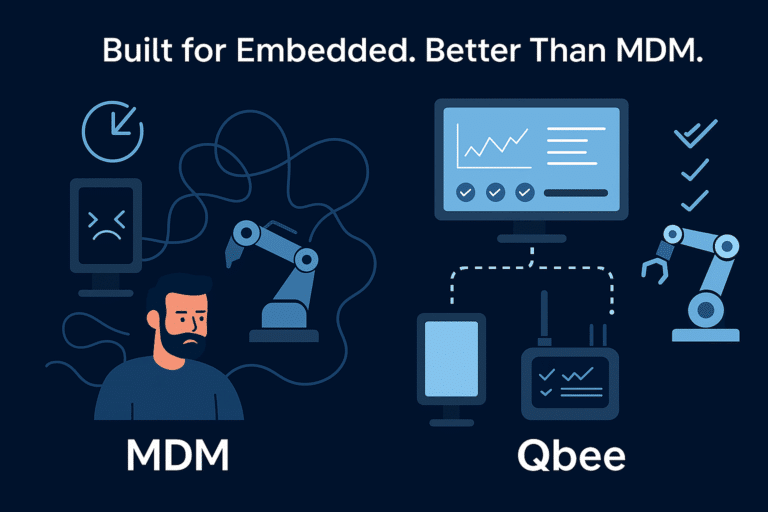The Rise of Single Purpose Devices – and the Risk of Getting it Wrong
Single Purpose Devices (SPDs) — like kiosks, digital signage, gateways, or smart controllers — are quietly powering the modern world. They sit in retail stores, factories, farms, and hospitals, doing their job day in and day out.
But there’s a problem: these devices aren’t being managed the way they should be.
Traditional tools like Mobile Device Management (MDM) systems were never built for this. They assume screens, user sessions, and app stores — not headless embedded Linux devices in the field running critical infrastructure.
Why MDM Falls Short
Here’s the reality: MDM solutions were built for phones and tablets. Not for embedded devices running on minimal hardware. That gap leads to major issues:
| Feature | Traditional MDM | Qbee |
|---|---|---|
| Device Compatibility | Built for mobile (iOS/Android) | Built for Linux-based embedded devices |
| Remote Updates | App-level only | Full OS, package, and config updates |
| Automation | Limited scripting | Configuration-as-code (GitOps) |
| Monitoring & Logs | Basic visibility | Live monitoring, logs, metrics |
| Security Focus | User-centric policies | Embedded-first with vulnerability scans |
| Performance on Low-Power Devices | High overhead, heavy agents | Lightweight, edge-optimized |
| Use Case Fit | Phones, tablets, user interaction | Headless, unattended, mission-critical devices |
If you’re managing real-world, unattended devices — MDM will either break, stall, or bloat.
What Modern SPD Management Should Look Like
Qbee was built for this exact purpose. We’re purpose-built for non-interactive devices that need to work securely at scale. Here’s what that looks like:
- Zero-touch updates with rollback and versioning
- Configuration-as-code — no more shell scripts or copy-paste setups
- Live monitoring and metrics so you’re never in the dark
- Lightweight and edge-ready — built for resource-constrained environments
- Built-in vulnerability scanning on libraries and packages
With Qbee, you’re not forcing a smartphone tool into a server role. You’re using the right tool for the job.
Companies like ShipMonk use Qbee to manage thousands of unattended Linux-based SPDs powering their warehouse automation — devices that would be completely invisible to an MDM.
If your devices are doing real work — not just displaying apps — you need more than user-based management.
You need embedded-first orchestration.
Why Qbee?
Because building your own update scripts and cron jobs isn’t a strategy — it’s a liability.
Qbee lets you:
- Replace ad-hoc scripts with structured, version-controlled configuration
- Secure your entire fleet, not just individual endpoints
- Push updates in minutes — not days or site visits
- Skip the overhead of MDM, and get something built for embedded fleets
Final Thought
SPDs are small, quiet, and invisible — until they stop working.
Then they become your biggest operational headache.
Qbee gives you control, insight, and security — all with zero manual overhead.
Ready to skip the MDM workarounds and DIY struggles?
👉 Try Qbee – it’s free to get started.







